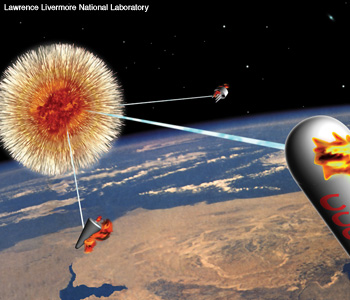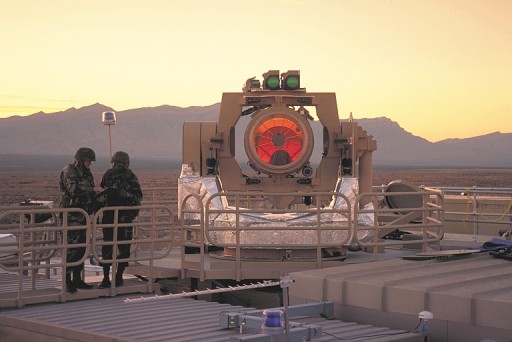The Strategic Defense Initiative (SDI) was proposed by U.S. President Ronald Reagan on March 23, 1983, to use ground and space-based systems to protect the United States from attack by strategic nuclear ballistic missiles. The initiative focused on strategic defense rather than the prior strategic offense doctrine of mutual assured destruction (MAD). The Strategic Defense Initiative Organization (SDIO) was set up in 1984 within the United States Department of Defense to oversee the Strategic Defense Initiative.
 The ambitious initiative was widely criticized as being unrealistic, even unscientific as well as for threatening to destabilize MAD and re-ignite "an offensive arms race". In light of Reagan's vocal criticism of the MAD doctrine (Mutually Assured Destruction) the SDI (Strategic Defense Initiative) was an important part of his defense policy intended to offset MAD bias. It was soon derided, largely in the mainstream media, as "Star Wars," after the popular 1977 film by George Lucas.
The ambitious initiative was widely criticized as being unrealistic, even unscientific as well as for threatening to destabilize MAD and re-ignite "an offensive arms race". In light of Reagan's vocal criticism of the MAD doctrine (Mutually Assured Destruction) the SDI (Strategic Defense Initiative) was an important part of his defense policy intended to offset MAD bias. It was soon derided, largely in the mainstream media, as "Star Wars," after the popular 1977 film by George Lucas. The intent of this program was to develop a sophisticated anti-ballistic missile system in order to prevent missile attacks from other countries, specifically the Soviet Union. With the tension of the Cold War looming overhead, the Strategic Defense Initiative was the United States’ response to possible nuclear attacks from afar.
The weapons required included space- and ground-based nuclear X-ray lasers, subatomic particle beams, and computer-guided projectiles fired by electromagnetic rail guns all under the central control of a supercomputer system.” By using these systems, the United States planned to intercept intercontinental ballistic missiles while they still flew high above the Earth, minimizing their effects. However, there was a large power requirement for these types of weapons power requirements so vast that nuclear power was the method of choice. Thus, as the reality of creating numerous nuclear plants diminished, so did the ambitious designs.
 An early focus of the project was a curtain of X-ray lasers powered by nuclear explosions. The curtain was to be deployed using a series of missiles launched from submarines or, later on, satellites, during the critical seconds following a Soviet attack. The satellites would be powered by built-in nuclear warheads in theory, the energy from the warhead detonation would be used to pump a series of laser emitters in the missiles or satellites, allowing each satellite to shoot down many incoming warheads simultaneously. The attraction of this approach was that it was thought to be faster than an optical laser, which could only shoot down warheads one at a time, limiting the number of warheads each laser could destroy in the short time 'window' of an attack.
However, on March 26, 1983, the first test, known as the Cabra event, was performed in an underground shaft and resulted in marginally positive readings that could be dismissed as being caused by a faulty detector.
An early focus of the project was a curtain of X-ray lasers powered by nuclear explosions. The curtain was to be deployed using a series of missiles launched from submarines or, later on, satellites, during the critical seconds following a Soviet attack. The satellites would be powered by built-in nuclear warheads in theory, the energy from the warhead detonation would be used to pump a series of laser emitters in the missiles or satellites, allowing each satellite to shoot down many incoming warheads simultaneously. The attraction of this approach was that it was thought to be faster than an optical laser, which could only shoot down warheads one at a time, limiting the number of warheads each laser could destroy in the short time 'window' of an attack.
However, on March 26, 1983, the first test, known as the Cabra event, was performed in an underground shaft and resulted in marginally positive readings that could be dismissed as being caused by a faulty detector.Since a nuclear explosion was used as the power source, the detector was destroyed during the experiment and the results therefore could not be confirmed. Technical criticism based upon unclassified calculations suggested that the X-ray laser would be of at best marginal use for missile defense. Such critics often cite the X-ray laser system as being the primary focus of SDI, with its apparent failure being a main reason to oppose the program. However, the laser was never more than one of the many systems being researched for ballistic missile defense. Despite the apparent failure of the Cabra test, the long term legacy of the X-ray laser program is the knowledge gained while conducting the research. A parallel developmental program advanced laboratory X-ray lasers for biological imaging and the creation of 3D holograms of living organisms. Other spin-offs include research on advanced materials like SEAgel and Aerogel, the Electron-Beam Ion Trap facility for physics research, and enhanced techniques for early detection of breast cancer.

Beginning in 1985, the Air Force tested an SDIO-funded deuterium fluoride laser known as Mid-Infrared Advanced Chemical Laser (MIRACL) at White Sands Missile Range.The system was later tested on target drones simulating cruise missiles for the US Navy, with some success. After the SDIO closed, the MIRACL was tested on an old Air Force satellite for potential use as an Anti-satellite weapon, with mixed results.
The technology was also used to develop the Tactical High Energy Laser, (THEL) which is being tested to shoot down artillery shells.[
The Missile Defense Agency's Airborne Laser program uses a chemical laser which has successfully intercepted a missile taking off, so an offshoot of SDI could be said to have successfully implemented one of the key goals of the program.
In July 1989, the Beam Experiments Aboard a Rocket (BEAR) program launched a sounding rocket containing a neutral particle beam (NPB) accelerator. The experiment successfully demonstrated that a particle beam would operate and propagate as predicted outside the atmosphere and that there are no unexpected side-effects when firing the beam in space. After the rocket was recovered, the particle beam was still operational. According to the BMDO, the research on neutral particle beam accelerators, which was originally funded by the SDIO, could eventually be used to reduce the half-life of nuclear waste products using accelerator-driven transmutation technology.
The High Precision Tracking Experiment (HPTE), launched with the Space Shuttle Discovery on STS-51-G, was tested June 21, 1985 when a Hawaii-based low-power laser successfully tracked the experiment and bounced the laser off of the HPTE mirror. The Relay mirror experiment (RME), launched in February 1990, demonstrated critical technologies for space-based relay mirrors that would be used with an SDI directed-energy weapon system.
Launched on the same rocket as the RME, the Low-power Atmospheric Compensation Experiment (LACE) satellite was built by the United States Naval Research Laboratory (NRL) to explore atmospheric distortion of lasers and real-time adaptive compensation for that distortion.
LACE was also used to evaluate ground-based adaptive optics, a technique now used in civilian telescopes to remove atmospheric distortions.
Research out of hypervelocity railgun technology was done to build an information base about rail guns so that SDI planners would know how to apply the technology to the proposed defense system. The SDI rail gun investigation, called the Compact High Energy Capacitor Module Advanced Technology Experiment (CHECMATE), had been able to fire two projectiles per day during the initiative.
Hypervelocity rail guns are, at least conceptually, an attractive alternative to a space-based defense system because of their envisioned ability to quickly shoot at many targets. Also, since only the projectile leaves the gun, a railgun system can potentially fire many times before needing to be resupplied.
In 1987, the American Physical Society concluded that a global shield such as "Star Wars" was not only impossible with existing technology, but that ten more years of research was needed to learn whether it might ever be feasible.
Meanwhile emerging technologies 30 years on are beginning to prove a possibilities as tracking systems and lasers are being proposed in the next generation of weapons and defense arsenal.
One example is the Navy's Laser Weapon System (LaWS), guided by Raytheon's Phalanx Close-In Weapon System sensors, engaged and destroyed four UAV targets flying over water near the Navy's weapons and training facility on San Nicolas Island in California's Santa Barbara Channel, about 120 kilometers west of Los Angeles.
The Strategic advantage of a military defense has many advantages, as enemies could be monitored and fired upon.
Ridiculous as it seems but over 17,000 Americans have signed an on-line White House petition to ‘secure resources and funding’ for the construction of ultimate weapon, the Death Star. The founder of the campaign outlines the benefits of the campaign for America, claiming that the construction of the Death Star would provide an employment boost as well as enhancing America’s defenses. Although the petition seems to be gathering increasing support, it would require around 20,000 signatures for it to be officially reviewed by the White House. Considering that the cold war is over and the Russians may not be the Arch rivals of the space race. However UN Security Council has condemned North Korea for launching a missile in defiance of a UN resolution.
The US and its allies view the launch as a disguised ballistic missile test. White House spokesman Jay Carney would not specify what "consequences" Washington was considering, saying it would first assess what action was taken by the Security Council.
The rocket had been scheduled to pass between the Korean peninsula and China, with a second stage coming down off the Philippines. The Japanese government, which put its armed forces on alert ahead of the launch, said the rocket had passed over parts of Okinawa prefecture, south of the Japanese mainland.
Although North Korea may pose as a potential threat, it is probably unlikely that they have the sophisticated technology research for targeting nuclear missiles or for further development, as most of the country's limited resources are spent on the military.
The recurring theme of space still has an attraction that will no doubt continue to fascinate some people. But the technology or ideas born from The Strategic Defense Initiative, will likely be on small scale on earth bound vehicles. Meanwhile the growing Commercial interest in the idea of space hotels and manufacturing plants might have a military presence. Its likely that a space platform of any kind will require a co-operation on an international level. Hopefully the scientific and recreational uses of a space station will probably win out over the need to be strategically superior over certain countries...










No comments:
Post a Comment